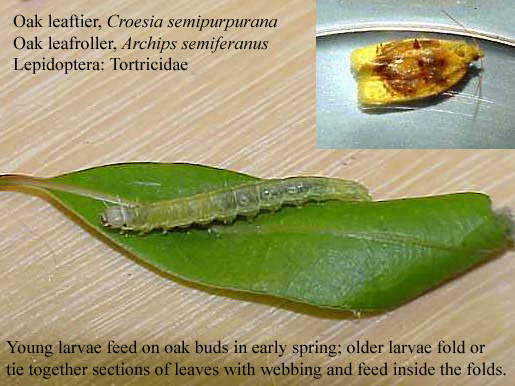
During the spring residents of central Florida may find little green caterpillars hanging on silken threads from their oak trees. These insects have common names like oak leaftier, oak leaf shredder, and oak leafroller, depending on the species and feeding habits. Leaftiers tie several leaves together with silk and feed between them. Leafroller larvae roll leaves, tie them with silk, and then feed and rest within. Leaf shredding is a sign that young larvae made tunnels through the leaf buds as the buds were beginning to expand.

Biology. Whatever the species and feeding habits, all these insects have the same general life cycle. Eggs are laid on the small branches of host trees in the late spring. Hatch occurs early the following spring when the oak leaves began to grow. Larvae feed and grow for about one month and then drop to the ground to pupate. Moths emerge within two weeks with females living a few days and laying up to 100 eggs. Then we see nothing more of these insects until the following year.
Tree Health and Insect Management. Two years of severe defoliation can stress trees and produce some branch dieback, but such defoliation rarely happens in Florida. The common scenario is several years of light to moderate defoliation, then insect populations collapse and we are unaware of these insects for a number of years. Watering the trees for several months following the defoliation is generally all that is necessary to maintain their vigor. Fertilization is unnecessary as caterpillar droppings provide the nitrogen for growing new leaves. Chemical control is justified only when severe defoliation is anticipated, the ideal time for applying an insecticide being just before the insects begin their last week of voracious feeding.
Taxonomy. In the northeastern United States the oak leafroller complex has about 20 species belonging to five families of Lepidoptera. One of the species present in Florida is the oak leaftier, Croesia semipurpurana (Lepidoptera: Tortricidae). Adults of this species, as pictured above, are less than one-half-inch long with yellow wings containing a brown blotch. Adults of another species, Archips semiferanus, are a little larger and have wings that are creamy brown and gray with a dark oblique band. Additional information on these two species can be found on the following US Forest Service web pages:
Other Spring Defoliators. Tussock moth caterpillars and the forest tent caterpillar are other spring defoliators of oak trees. For information on tussock moth caterpillars in Florida go to
http://eny3541.ifas.ufl.edu/tussock/orgyia.htm.
Excellent information on the forest tent caterpillar can be found in the US Forest Service leaflet at
http://www.na.fs.fed.us/spfo/pubs/fidls/ftc/tentcat.htm.
County Agents - Whenever your county has high populations of any of these defoliators, please let me know by sending an email message to foltz@ufl.edu. Such information helps us document the location and the ups and downs of outbreaks of these insects.
The University of Florida Pest Alert website is at:
http://extlab7.entnem.ufl.edu/PestAlert/
The Forest and Shade Tree Insects website is at
http://eny3541.ifas.ufl.edu/